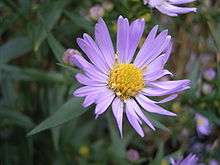Symphyotrichum novi-belgii
Symphyotrichum novi-belgii, the New York aster,[3] is a species of flowering plant. It is the type species for Symphyotrichum, a genus of the family Asteraceae, whose species were once considered to be part of the genus Aster. Plants in both these genera are popularly known as "Michaelmas daisy" because they bloom around September 29, St. Michael’s Day.
| Symphyotrichum novi-belgii | |
|---|---|
 | |
| New York aster | |
| Scientific classification | |
| Kingdom: | Plantae |
| Clade: | Tracheophytes |
| Clade: | Angiosperms |
| Clade: | Eudicots |
| Clade: | Asterids |
| Order: | Asterales |
| Family: | Asteraceae |
| Genus: | Symphyotrichum |
| Species: | S. novi-belgii |
| Binomial name | |
| Symphyotrichum novi-belgii | |
| Synonyms[1][2] | |
| |
The Latin specific epithet novi-belgii (literally "New Belgium") refers to the 17th century Dutch colony New Netherland which was established on land currently occupied by New York State.[4]
Symphyotrichum novi-belgii grows in abandoned fields and wet meadows in eastern Canada and the northeastern United States.
Distribution
- Native
-
- Nearctic
- Eastern Canada: New Brunswick, Newfoundland, Nova Scotia, Prince Edward Island, Quebec
- Northeastern United States: Connecticut, Maine, Massachusetts, New Hampshire, New York, Rhode Island, Vermont
- Southeastern United States: Delaware, Georgia, Maryland, North Carolina, South Carolina, Virginia
Source: GRIN[5]
Cultivation
This is the largest group of Michaelmas daisies, with over 1,000 named cultivars. They are valued for their late summer color in shades of blue, pink and white. They are best planted in an open, sunny position. While extremely tough, they are susceptible to fungal infections, especially if conditions are not ideal. The cultivar 'Fellowship'[6] has gained the Royal Horticultural Society's Award of Garden Merit.
Etymology
Novi-belgii means 'from New York', which was formerly named Novum Belgium ('New Belgium').[7]
References
- "Symphyotrichum novi-belgii". International Plant Names Index (IPNI). Royal Botanic Gardens, Kew. Retrieved 2008-06-08.
- "Details for: Symphyotrichum novi-belgii". Euro+Med PlantBase. Berlin-Dahlem Botanical Garden and Botanical Museum, Freie Universität Berlin. Retrieved 2008-06-08.
- "Symphyotrichum novi-belgii". Natural Resources Conservation Service PLANTS Database. USDA. Retrieved 6 December 2015.
- Harrison, Lorraine (2012). RHS Latin for Gardeners. United Kingdom: Mitchell Beazley. ISBN 184533731X.
- "Symphyotrichum novi-belgii". Germplasm Resources Information Network (GRIN). Agricultural Research Service (ARS), United States Department of Agriculture (USDA). Retrieved 2008-06-08.
- "RHS Plant Selector - Aster novi-belgii 'Fellowship'". Retrieved 17 July 2013.
- Gledhill, David (2008). "The Names of Plants". Cambridge University Press. ISBN 9780521866453 (hardback), ISBN 9780521685535 (paperback). p 275
External links
| Wikimedia Commons has media related to Symphyotrichum novi-belgii. |
| Wikispecies has information related to Symphyotrichum novi-belgii |
- "Symphyotrichum novi-belgii var. novi-belgii". Natural Resources Conservation Service PLANTS Database. USDA. Retrieved 2008-06-08.
- "Symphyotrichum novi-belgii". Integrated Taxonomic Information System. Retrieved 6 June 2008.
- Connecticut Botanical Society: Symphyotrichum novi-belgii